Writing interesting content, relevant to your business, is a great way to start your content marketing strategy. But writing content really is just the start. In a world where over 2.75 million blog posts are published each day, just writing content to push your services or products isn’t enough to stop your work being buried under an avalanche of indexed content.
So how do you write engaging content that ranks high in search results?
The answer is SEO Copywriting.
And I am going to show you 18 SEO Copywriting tips that will boost your search engine rankings.
What is SEO Copywriting?
Lets firstly look at traditional website copywriting. This is essentially writing copy to increase your brand awareness and to persuade your target audience to take action. The action might be for them to click on a purchase or sign up button. It might be to submit an email address or click on a social media share link.
So where does SEO come into this?
On-page Search Engine Optimization (SEO) includes techniques used to boost your rankings based on what we know about Google’s algorithms. This, among other factors, concerns using your keywords in your content in the right places. It looks at how you form your title tag, URL, image alt text and the page content.
SEO Copywriting is about combining SEO and Copywriting together to form a strategy that will see your pages rocket up search engine rankings.
Now that we know what SEO Copywriting is, let’s take a look at some easy to action tips you can use right away.
SEO Copywriting Tips
Table of contents
- Do your research
- Add eye catching headings and subheadings
- Use the Inverted Pyramid Technique
- Add Bucket Brigades
- Use The APP Method (Agree, Promise and Preview)
- Use Latent Semantic Indexing (LSI) keywords
- Optimize your title tag
- Optimize your Meta Description
- Add a Call To Action
- Use a consistent message
- Embed video
- Add original images
- Use relevant file names and alt tags for images
- Add a Table of contents with jump link text for long articles
- Use the Hemingway App
- Write in the audience’s language
- Use internal and external links
- Write evergreen content
1. Do your research
Before you begin writing your own content it’s always a good idea to get on Google search to see what your audience and your competition are up to. Take particular interest in content that is ranking high for keywords you want to use. Also look at the “People also ask” and the related searches that Google gives you. This is not only good for keyword research but also gives you a good understanding of the type of content people are looking for.

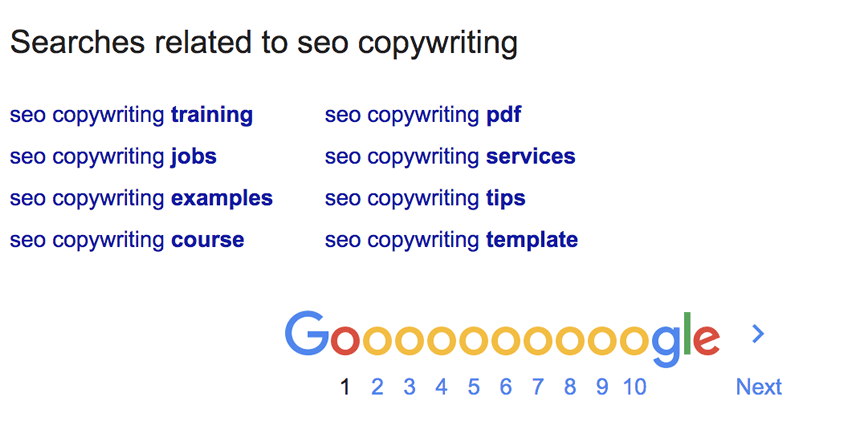
To find out what people are searching for is not limited to Google alone. You can check out lots of other places such as Quora, Facebook groups, Reddit, forums and anywhere else you can think of related to your industry.
What questions are being asked on these platforms? Find out and answer them in your content.
Search intent is another factor for you to consider as part of your research. You may have a great keyword in mind. But is it suited to the content you are looking to write?
For example, you might want to write an article about how to do something. But most people searching using your keyword want to buy the product and not learn how to use it. This is transactional intent. In this case product pages will rank higher than “how to” pages.
The 4 types of search intent:
- Informational: This is simply people looking for information. They might ask questions such as “What is the capital of Scotland?” or “How do you cook an omelette?”. Or it could just be “Scotland’s capital” or “Cook an omelette”.
- Navigational: Often, people know the website they want to go to but can’t remember the specific web address for that site. Or like me they just find it quicker to Google it!
- Transactional: An estimated 1.8 billion people shop online. This means a lot of people will be searching with transactional intent. They will have a product in mind and their purpose will be to make a purchase.
- Commercial Investigation: Some people may have transactional intent in the future but want to do some research first. These people have commercial investigating intentions. They will be searching for things like “Which laptop is best for editing video?” or “What is the safest family car?”
So before you start using a keyword in your content, have a think about search intent and the impact it will have on your page rankings.
Research is number one of my SEO Copywriting tips for a reason. Once you have a good understanding of your customers and their intent, the rest of these tips become much easier to action.
2. Add eye catching headings and subheadings
Headings and subheadings should be used naturally to break up your content and make it more readable. Web page visitors tend to skim content to look for a section they are most interested in. Clear headers help them find what they are looking for. These headers should be eye catching in order to encourage your visitors to continue reading.
Your headings and subheadings are also a great place to add your keywords or related keywords. This gives Google a better understanding of what your content is about. Don’t overdo this however. Make sure your headings are relevant to the content below them.
When writing an article I use my headers and sub headers as my framework. These go into the article first to help me see how the content should be ordered and to make sure I have covered all the main points.
3. Use the Inverted Pyramid Technique
Let’s be honest here, we can be an impatient bunch! When we ask a question on a Google search, we want an answer straight away. For this reason, it is important to add the most important information at the start of your article. This is called the Inverted Pyramid Technique.
The rest of your article is still going to be amazing of course and will go into much more detail on your subject. But start off with a bang. This will keep the reader happy that they have the answer they are looking for and they will trust that you know what you are talking about. Subsequently, this will encourage them to read further into your article and learn about the finer details.
From an SEO point of view this will improve the amount of time the visitor spends on your page. Dwell time is a factor that Google takes into consideration when ranking your page.

4. Add Bucket Brigades
Keeping people on your page is key to achieving higher rankings. When visitors hang around on your page this tells Google that you have valuable content. We have already looked at adding great headings and using the inverted pyramid technique to hold your readers interest.
But what about the main bulk of your content?
How do you keep visitors engaged?
Use Bucket Brigades!
Bucket Brigades have been used in sales copy for a long time. The idea is that short attention grabbing sentences (or sometimes only one or two words), similar to the one’s above, hold the reader’s attention and encourage them to read on.
Add bucket brigades into your content where you feel readers might want to leave. This could be after they have found the answer they were looking for. Draw them back in with a short interesting sentence.
You can also use other catchy tactics in your copy such as quote boxes or bullet points. Visitors to your web pages will scan your content. So make sure it is structured in a way that makes it easy to scan.
5. Use The APP Method (Agree, Promise and Preview)
If there is someone out there who can write a great post it is Brian Dean. The SEO expert uses a method called APP (Agree, Promise and Preview). This is similar to another copywriting method called PAS (Problem, Agitate and Solve). The method looks like this on a page:
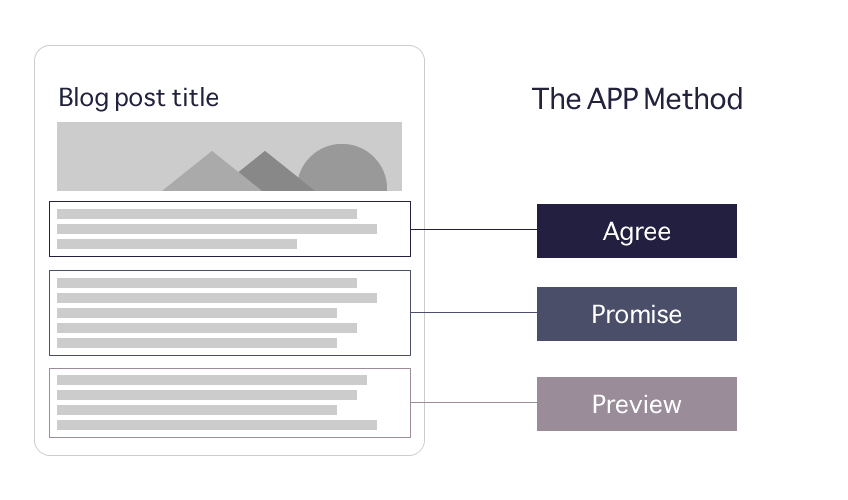
The Agree part is where you state the problem. This should match whatever the reader has searched for in Google. You are showing that you understand and agree with the issue the reader is having.
Then you offer the Promise. You tell the reader that their problem can be solved and you know exactly how to solve it.
The final part of your APP is Preview. Here you will summarise very briefly how you are going to solve their problem. As I said earlier with the Inverted Pyramid Technique, visitors can be impatient so let’s give them a quick version of the answer they are looking for near the top of the article.
Using APP at the top of your article will engage the reader instantly and encourage them to dig deeper into your content.
6. Use Latent Semantic Indexing (LSI) keywords
Chucking your keyword into your content every other sentence will do you more harm than good these days. But what Google does like is LSI keywords – otherwise referred to as related keywords. Google’s algorithms are improving all the time and it uses related keywords to work out exactly what your page is about.
Finding related keywords is pretty straight forward. One of the easiest ways is to Google your main keyword and scroll down to the People also ask box and the related searches. This is Google telling us what other people are searching for related to your search. Adding these to your article gives your readers and Google a better understanding of your content.
If you want to dig a bit deeper then use an online tool such as UberSuggest or SEMRush. Enter your main keyword and these tools will show you related keywords and how often people search for them.
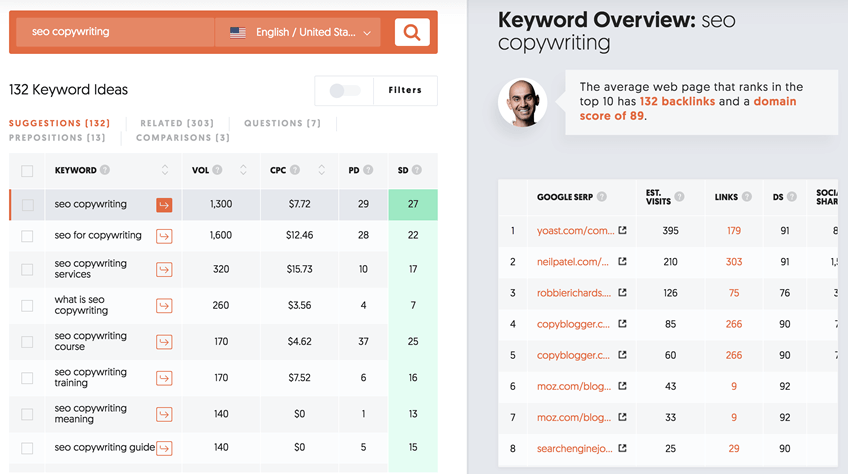
Related keywords should be added throughout your content but only when relevant. Google will then be able to fully understand the topic of your article and this will improve your search rankings.
7. Optimize your title tag
The title tag for this page could easily have just been “SEO Copywriting tips”. Nice, short, straight to the point and contains my keyword. If you searched for that keyphrase, that is the title you would see in the Google search results. Now let’s look at that title along with the one I have actually used:
“SEO Copywriting tips”
“18 simple SEO Copywriting tips to boost your rankings”
Which one are you most likely to click on? Stats show that most people are far more likely to click on the second one. Adding modifiers like “simple” and “boost your rankings” to your title tags will also increase your rankings for long tail keywords. For example someone might search for “simple SEO Copywriting tips” or “SEO Copywriting tips to boost rankings” rather than just “SEO Copywriting tips”.
Another addition to this title tag is the number at the start. People prefer this in certain titles as it tells them exactly what is in the article. It’s not going to be just 2 tips or as long as 50 tips. The title says it’s going to be 18 tips so you know what you will be getting. In some cases adding the current year at the end of your title can also help to make your article look fresh.
Adding “boost your rankings” is a powerful statement. This lets the reader know they are going to learn something that will provide a positive impact. Using power words and emotion will make your titles stand out in search results.
8. Optimize your Meta Description
Meta descriptions are often undervalued and sometimes overlooked by website owners. This is pretty crazy seeing as the meta description is the second thing related to your website that someone will see in a Google search. After your title you have 160 characters to convince someone to click on your link. So you need to use this space wisely.
Your keywords will of course have to be in the description and they will be bolded by Google. Writing your meta description is there to convince the searcher to click on your link. It should also follow a few basic rules:
- Google will truncate your snippet to about 160 characters max
- Use your keyword
- Make it unique – don’t copy and paste from another post or page
Follow these steps where possible and above all make your meta description interesting. Does it explain your page clearly and does it entice the user to find out more?

9. Add a Call To Action
Right back at the start of this article we talked about persuading your visitors to take some form of action on your page. Ultimately that is your goal. To do this we need to add a Call To Action (CTA) within your content at least once. This tells the reader what they should do next.
Your website will undoubtedly have goals to achieve. This might be newsletter sign ups, products for sale, downloads or social share buttons to be clicked. Your CTA will depend on how you see your buyers journey and how you adapt that to fit your marketing funnel.
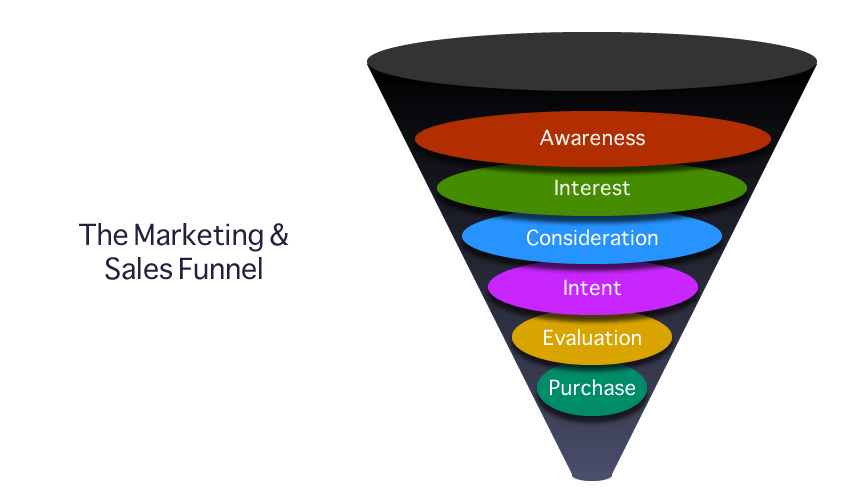
Your CTA should stand out from the rest of your article. On most websites this will be a nicely designed button or banner. It could also be a form or pop-up. It again really depends on the customer journey you are looking to implement.
10. Use a consistent message
Your brand and its story are the foundation of your business. Customers need to know what you are offering and what you are about. Keep this message consistent throughout your content.
Try to keep your sales content, such as special offers or incentives, simple and consistent throughout your site. Don’t confuse the potential customer. There is nothing more off putting than seeing a great offer splashed over a home page then seeing a different offer for the same thing on the product page.
You have to earn the visitors trust or they won’t hang around and certainly won’t buy anything from you. A consistent message throughout the customer journey from the moment they first engage is crucial. Also make sure the same message is used over all of your media from print to social media.
11. Embed video
YouTube’s outrageous user stats tells us that people love video content. In my experience blog posts with videos generate more inbound links and increased views than those without.
There will be certain circumstances where an instruction is better explained in a video rather than written words. This might be a video you put together yourself or one you have sourced from YouTube. Either way this adds value to your visitors experience and will improve dwell time on your page.
Embedding a video into your content couldn’t be easier. YouTube provides you with a snippet of code that you copy and paste into your page.
12. Add original images
First and foremost, images make posts look better. They break up long pieces of text and can add value to your content where words might not have the same impact. I talked about infographics in another post and how these have potential to increase traffic by people sharing them on social media or other blogs. But adding visual appeal doesn’t always have to be as time consuming as creating infographics.
Graphs or screenshots that emphasize particular points can be added to hold your readers attention. Although stock images from websites such as Pixabay do add appeal, they don’t have the same effect as adding something original. Do you really want to use images that are used on lots of other websites?
But I am not a graphic designer I hear you say!
The thing is you really don’t have to be. Free online tools like Piktochart (for graphs, charts, stats), Canva (banners, logos) and BeFunky (photograph editing) allow you to put great visuals together in no time.
Always remember to compress your images to keep your pages loading quickly. Slow pages will affect your Google rankings. A great tool for doing this is TinyPNG. If you are using WordPress then Smush is also very good for reducing image file sizes.
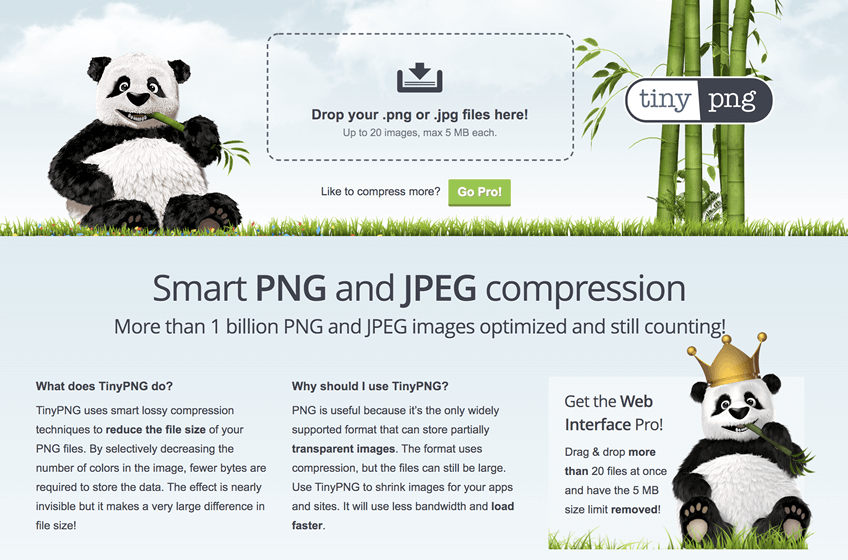
13. Use relevant file names and alt tags for images
Following on from the point above, adding images to your content can also get you lots of extra traffic. To do this you have to give your images names and alt tags that are relevant to your content.
You need to let Google understand what your images are. If you have an image of the New York skyline at night then name your file something like new-york-skyline-at-night.png. Along with your alt text this will also improve your chances of appearing in a Google image search for “New York Skyline at Night”.
Alt tags are alternative text used when an image can’t be displayed. Therefore your alt tag should tell us exactly what the image is. The other benefit of using good alt tags is that helps your SEO. Try to relate at least one image in your content to your keyword for that page. But also don’t duplicate your alt tags.
Google also suggests that you use an image sitemap. These simple steps can provide you with useful extra organic traffic.
14. Add a Table of contents with jump link text for long articles
If your article is long (I consider over 2000 words to be a long article), I recommend adding a table of contents at the top or at least near the top of your article. Some visitors to your page might only be interested in reading one or a few specific sections of your post.
Adding a table of contents requires clear relevant headers as discussed back at point 2 in this article. When I am reading a long article I find these very helpful. I can use the quick links to jump to the information that I need at that point. It would also make me far more likely to return to that article rather than one where I have to spend a lot of time finding information that is important to me.
15. Use the Hemingway App
Try not to use complicated words and long sentences. This can drive a lot of customers away. You are trying to get a clear message over to your customers, not impress them with fancy words!
Hemingway is a free app that allows you to paste in your text and receive readability results. It is inspired by famous American novelist Ernest Hemingway who was known for a simple and direct writing style. Remember that this is what web content readers want – easy to read articles that are straight to the point.

If you have a WordPress website I recommend installing the free Yoast plugin. Not only will it help you with technical SEO but it also gives your content a readability score. The plugin offers some great tips for improving your posts readability and therefore keeping your readers happy.

16. Write in the audience’s language
Back at number 1 in this list we looked at customer research. It’s a good idea to follow similar steps when thinking about the tone and feel of your content. What kind of language and phrases are your customers using on other platforms? Think of technical terms used in your industry that they will be familiar with.
Relate to your visitors as much as you can. Show them that you understand their problem. You have been there and done it and know how to solve it. If you use terms they don’t understand or that are not consistent with that niche they will soon head off to another website. The only way to get a good understanding of your target audience language and behaviour is by following or being part of their community. Forums, blogs, Reddit, Quora are just some places where you can do this.
17. Use internal and external links
Internal linking is the process of adding links on your website to other pages or posts within the same website. This allows the reader to find related information on your site that they may be interested in. Having visitors stay on your site for as long as possible is good for many reasons including your Google rankings. It also improves your internal link structure. This is something else that search engines approve of.
Adding external links to your article that are relevant is another good indicator that tells Google what your content is about. These links should always be to trusted sources. What you don’t want to do is link to a website that won’t exist in a few months time. Also from a readers point of view, external links help to support your content with additional information. This could for example be an external link to a website of an official source offering statistics that prove a point you are trying to convey.
But don’t go crazy with external links. Just add them into your content where you feel they will add more value for the reader.
18. Write evergreen content
There will be some topics in your field that will stand the test of time. This is content that can be written and still be relevant after several years. Evergreen content tends to come in the form of informative guides or lists. The content is of a very high standard and remains fresh for new readers. This type of content can be a godsend as it continues to bring in valuable traffic consistently over a length of time.
What evergreen content isn’t is latest news articles or latest trends in your industry. This type of content is still important and should still be the basis of most of your content. But having a few evergreen articles as well will provide a steady stream of traffic. Evergreen content should be so good it is sharable, helping your link building possibilities as well.
SEO Copywriting – next steps
So that’s my 18 simple SEO Copywriting tips that I firmly believe will boost your search engine rankings. These tips are all actionable and you can get started creating content with them right away.
Remember, your content should always be relevant and never compromised by technical factors. But as we can see from my tips, technical SEO and great content can work hand in hand. More so, by incorporating these simple tips, you will see a significant increase in your blog traffic.
Do you have any great SEO Copywriting tips that work for you that didn’t make my list? If so, I would love to hear about them.




[…] when it comes to backlinks. Having high authority websites linking back to your website will boost your rankings significantly. Often these can be achieved just by having great content that other websites want to […]
It was a wonderful time while going through your article and I’ve got what I was looking for
I’m so glad you chose to share this article. It’s given me a ton of great information that I need for myself, but it was just too hard trying to find everything on Google.
For beginners, this is a well-defined and quite instructive site. Thank you for sharing this information in such a straightforward yet beautiful manner.
Wish you all the best for your future endeavours. Once again, thank you for your valuable tips and ideas helping freshers like us. I will surely share this beautiful piece of article with my peers and people who actually need guidance.